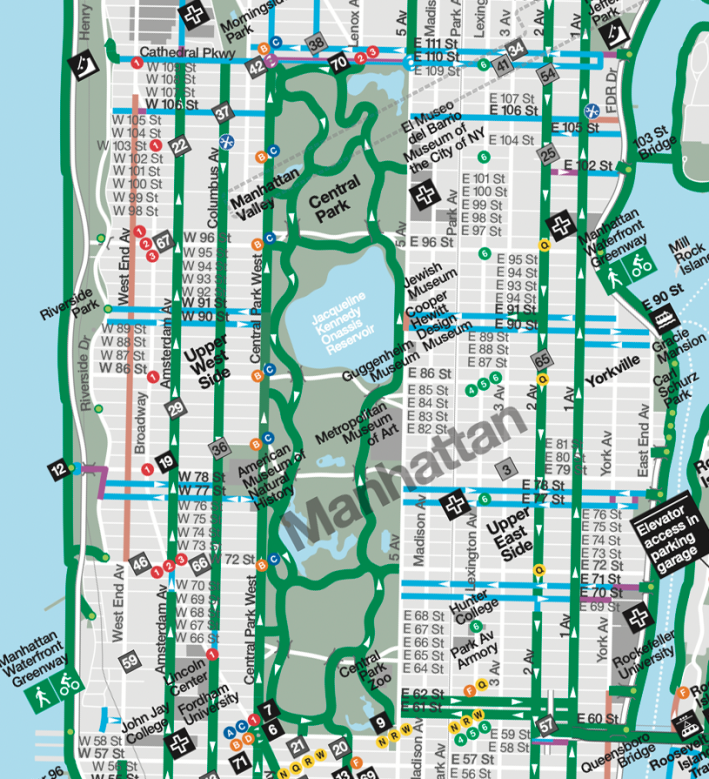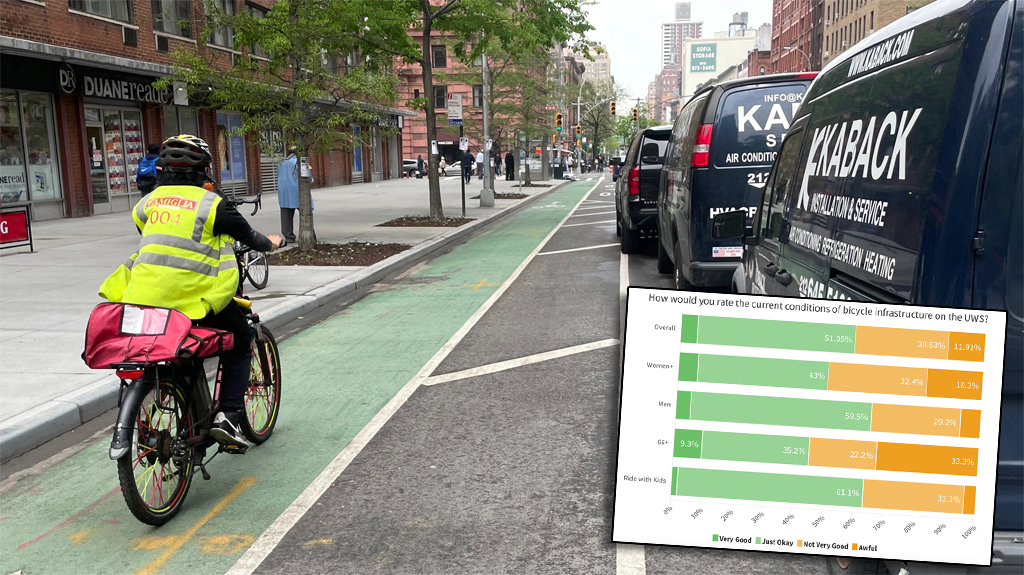The Upper West Side has more protected bike infrastructure than most New York City neighborhoods — but still not enough for many of its residents to feel safe biking or using other micro-mobility devices, according to a recent survey.
Streetopia UWS polled Upper West Siders and found that 26.3 percent of people identified as "interested" in using devices like bikes and scooters to get around the neighborhood, but remained "concerned" about being safe.
Concern was highest among women, seniors, and people with kids, with seniors the most likely to say "no way, no how" to urban cycling.
But the survey also showed room for optimism ... albeit with more city effort: A whopping 78 percent of respondents — including seven out of 10 women, four of 10 seniors and 94 percent of parents— said they would use bikes and scooters more if there was better infrastructure.
The Upper West Side has some of the best bike infrastructure in town — thanks to the Hudson River Greenway as well as protected lanes on Central Park West, Amsterdam Avenue, and Columbus Avenue — but its residents still don't perceive the neighborhood as safe: More than half of the survey's respondents called the neighborhood's bike infrastructure "just okay," while 31 percent said it was "not very good" and 12 percent called it "awful."
Only 5.5 percent of residents called the infrastructure "very good."
"My son is a good cyclist, he can bike well, but he's small. He's not nimble, and I wouldn't expect him to be. I would never let him bike in a bike lane adjacent to cars, unprotected by some sort of barrier," said resident Justin Gundlach, a father of a 6-year-old and 10-month-old who contributed to a survey of area bike lane conditions included in the report.
"Even on Columbus and Amsterdam, I'm really wary. I stay close to him when we ride there, and we haven't much," Gundlach said.
Gundlach's wife won't bike in the neighborhood at all, he said.
"Until infrastructure is very different, she's just not going to. We don't go places as a family on bikes because for the most part we can't," the father of two said.

"The infrastructure that's available to us, even though we live in one of the cushiest places in the city for cycling infrastructure, it's actually not that safe. You still get a lot of close calls because of that way things have been designed."
Streetopia UWS recently launched a campaign for crosstown protected lanes; at the moment there are none.
The group may face an uphill battle at Manhattan Community Board 7, whose members have spent the better part of the last 15 years forcing bike advocates through endless procedural hoops to get better infrastructure. A brief period of pro-bike lane peace followed the death of Madison Lyden in 2018, with CB 7 pushing for protected lanes on Central Park West where Lyden died. But the board more recently rejected a Parks Department proposal for an e-bike delivery worker rest stop outside the West 72nd Street subway station.
Manhattan mom Deborah Kerzhner, who lives on W. 111th Street, started biking to work "daily" after the city installed the Central Park West protected bike lane. Kerzhner, her husband, and their three kids have since become a "predominantly biking family," but they still often feel unsafe, she said.

The absence of safe bike lanes means the kids typically ride on the sidewalk — which is legal for them but a nuisance to other pedestrians — while Kerzhner and her husband keep lookout. Her senior citizen parents, who also live in Manhattan, ride often but only in Central Park, Kerzhner said.
"The existence of bike lanes doesn't matter if there's not a network of bike lanes. If any trip I have to take has an unsafe portion, then the whole trip is as safe as its weakest link," Kerzhner said of the area's existing protected lanes.
"Everything is a conflict because my children are not cars. They don't go the speed of cars, they don't travel like cars. They need time, but cars don't want to give them that time. If they have [a protected] lane for themselves, they have that time."
Reluctance to bike among women, seniors, and others is not the exclusive domain of the Upper West Side. The recently released New York Cycling Census found that the lack of safe bike routes to be the "most frequent barrier to cyclist" for nearly three out of four New Yorkers statewide. And while CB7 ranks five of 59 citywide in terms of bike infrastructure, CB9 just to the north ranks 44th.
"Women, seniors, and families encounter the same conditions across the city that make them reluctant to ride in the Upper West Side," said Open Plans Co-Executive Director Sara Lind.
"If those riders feel marginalized, imagine how a curious cyclist in Flatbush feels considering their own, far sparser, mobility options.






